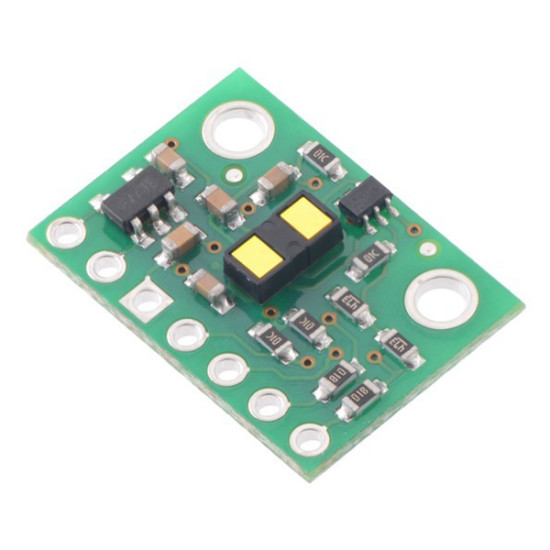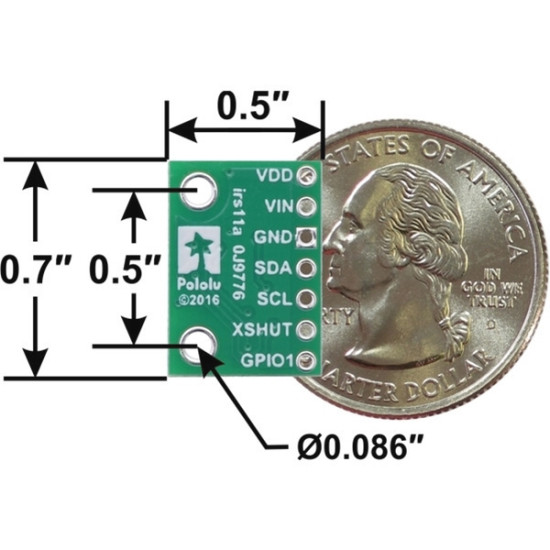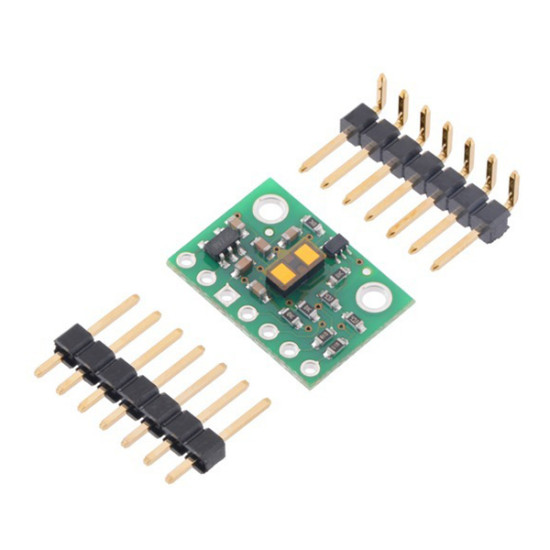







- Stock: Out Of Stock
- Brand: Pololu - USA
- Model: SEN-3749
- Weight: 0.09kg
- MPN: 3415
The VL53L1X from ST Microelectronics is a long-distance ranging time-of-flight (TOF) sensor integrated into a compact module. This board is a carrier for the VL53L1X, so we recommend careful reading of the VL53L1X datasheet before using this product.
The VL53L1X is effectively a tiny, self-contained lidar system featuring an integrated 940 nm Class 1 laser, which is invisible and eye-safe. Unlike conventional IR sensors that use the intensity of reflected light to estimate the distance to an object, the VL53L1X uses ST’s FlightSense technology to precisely measure how long it takes for emitted pulses of infrared laser light to reach the nearest object and be reflected back to a detector. This approach ensures absolute distance measurements independent of ambient lighting conditions and target characteristics (e.g. color, shape, texture, and reflectivity), though these external conditions do affect the maximum range of the sensor, as do the sensor configuration settings.
The VL53L1X is a great IC, but its small, leadless, LGA package makes it difficult for the typical student or hobbyist to use. It also operates at a recommended voltage of 2.8 V, which can make interfacing difficult for microcontrollers operating at 3.3 V or 5 V. Our breakout board addresses these issues, making it easier to get started using the sensor, while keeping the overall size as small as possible.
Features and specifications:
- Dimensions: 0.5″ × 0.7″ × 0.085″ (13 mm × 18 mm × 2 mm)
- Weight without header pins: 0.5 g (0.02 oz)
- Operating voltage: 2.6 V to 5.5 V
- Supply current: ~15 mA (typical average during active ranging at max sampling rate)
- Varies with configuration, target, and environment; peak current can reach 40 mA
- Fast and accurate ranging with three distance mode options:
- Short: up to ~130 cm, 50 Hz max sampling rate; this mode is the most immune to interference from ambient light
- Medium: up to ~300 cm in the dark, 30 Hz max sampling rate
- Long: up to 400 cm in the dark, 30 Hz max sampling rate
- Minimum range: 4 cm (objects under this range are detected, but measurements are not accurate)
- Emitter: 940 nm invisible Class 1 VCSEL (vertical cavity surface-emitting laser) – eye-safe
- Detector: 16×16 SPAD (single photon avalanche diode) receiving array with integrated lens
- Typical full field of view (FoV): 27°
- Programmable region of interest (ROI) size on the receiving array, allowing the sensor FoV to be reduced
- Programmable ROI position on the receiving array, allowing multizone operation control from the host
- Configurable detection interrupt thresholds for implementing autonomous low-power presence detection:
- target closer than threshold
- target farther than threshold
- target within distance window
- target outside of distance window
- no target
- Output format (I²C): 16-bit distance reading (in millimeters)
Connections:
At least four connections are necessary to use the VL53L1X board: VIN, GND, SCL, and SDA. The VIN pin should be connected to a 2.6 V to 5.5 V source, and GND should be connected to 0 volts. An on-board linear voltage regulator converts VIN to a 2.8 V supply for the VL53L1X IC. Note that if your input voltage is under 3.5 V, you can connect it directly to VDD instead to bypass the regulator; in this configuration, VIN should remain disconnected.
The I²C pins, SCL and SDA, are connected to built-in level-shifters that make them safe to use at voltages over 2.8 V; they should be connected to an I²C bus operating at the same logic level as VIN.
The XSHUT pin is an input and the GPIO1 pin is an open-drain output; both pins are pulled up to 2.8 V by the board. They are not connected to level-shifters on the board and are not 5V-tolerant, but they are usable as-is with many 3.3 V and 5 V microcontrollers: the microcontroller can read the GPIO1 output as long as its logic high threshold is below 2.8 V, and the microcontroller can alternate its own output between low and high-impedance states to drive the XSHUT pin. Alternatively, our 4-channel bidirectional logic level shifter can be used externally with those pins.

Documents / Downloads:
- VL53L1X datasheet
- VL53L1X Time-of-Flight sensor datasheet
- UM2356: VL53L1X API user manual
- Schematic
- Dimension
- AN4846: Using multiple VL53L0X in a single design
- UM10204 I²C-bus specification and user manual
Package includes:
- 1x VL53L1X Time-of-Flight Distance Sensor Carrier with Voltage Regulator
- 1x 7Pin Straight Male Header
- 1x 7Pin Right Angle Male Header










